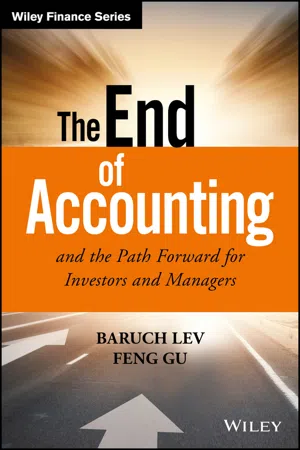
The End of Accounting and the Path Forward for Investors and Managers
- English
- ePUB (mobile friendly)
- Available on iOS & Android
The End of Accounting and the Path Forward for Investors and Managers
About This Book
An innovative new valuation framework with truly useful economic indicators
The End of Accounting and the Path Forward for Investors and Managers shows how the ubiquitous financial reports have become useless in capital market decisions and lays out an actionable alternative. Based on a comprehensive, large-sample empirical analysis, this book reports financial documents' continuous deterioration in relevance to investors' decisions. An enlightening discussion details the reasons why accounting is losing relevance in today's market, backed by numerous examples with real-world impact. Beyond simply identifying the problem, this report offers a solution—the Value Creation Report—and demonstrates its utility in key industries. New indicators focus on strategy and execution to identify and evaluate a company's true value-creating resources for a more up-to-date approach to critical investment decision-making.
While entire industries have come to rely on financial reports for vital information, these documents are flawed and insufficient when it comes to the way investors and lenders work in the current economic climate. This book demonstrates an alternative, giving you a new framework for more informed decision making.
- Discover a new, comprehensive system of economic indicators
- Focus on strategic, value-creating resources in company valuation
- Learn how traditional financial documents are quickly losing their utility
- Find a path forward with actionable, up-to-date information
Major corporate decisions, such as restructuring and M&A, are predicated on financial indicators of profitability and asset/liabilities values. These documents move mountains, so what happens if they're based on faulty indicators that fail to show the true value of the company? The End of Accounting and the Path Forward for Investors and Managers shows you the reality and offers a new blueprint for more accurate valuation.
Frequently asked questions
Chapter 1
Corporate Reporting Then and Now: A Century of “Progress”
Spot the Differences
| (in $ Millions) | ||
| Year 1902 | Year 2012 | |
| Sales | $ 560 | $19,328 |
| Cost of sales | (411) | (18,291) |
| Gross profit | 149 | 1,037 |
| Minus Expenses: | ||
| Selling & general expenses | (13) | (654) |
| Other gains/(losses) | 5 | (136) |
| Interest income | 3 | 7 |
| Interest expense | (9) | (247) |
| Income tax | (2) | (131) |
| Net income (loss) | 133 | (124) |
| (in $ Millions) | ||
| Year 1902 | Year 2012 | |
| Assets | ||
| Current Assets | ||
| Cash & equivalents | $56 | $570 |
| Net receivables | 49 | 2,090 |
| Inventories | 104 | 2,503 |
| Other current assets | 5 | 211 |
| Total current assets | 214 | 5,374 |
| Investments | 4 | 609 |
| Property, Plant & Equipment | 1,325 | 6,408 |
| Intangibles | — | 253 |
| Goodwill | — | 1,822 |
| Other noncurrent assets | 4 | 751 |
| Total assets | $1,547 | $15,217 |
| Liabilities | ||
| Current Liabilities | ||
| Accounts payable | $19 | $1,800 |
| Payroll payable | 4 | 977 |
| Accrued taxes | 1 | 146 |
| Other current liabilities | 26 | 67 |
| Total current liabilities | 50 | 2,990 |
| Long-term debt | 371 | 3,936 |
| Employee benefits | — | 4,416 |
| Other noncurrent liabilities | 30 | 397 |
| Total liabilities | 451 | 11,739 |
| Stockholders' Equity | ||
| Common stock | 1,018 | 3,282 |
| Retained earnings | 78 | 196 |
| Total shareholders' equity | 1,096 | 3,478 |
| Total Liabilities and Equity | $1,547 | $15,217 |
Table of contents
- Cover
- Title Page
- Copyright
- Table of Contents
- Dedication
- Acknowledgments
- The Book in a Nutshell
- Prologue
- Chapter 1: Corporate Reporting Then and Now: A Century of “Progress”
- Chapter 2: And You Thought Earnings Are the Bottom Line
- Part One: Matter of Fact
- Part Two: Why Is the Relevance Lost?
- Part Three: So, What's to Be Done?
- Part Four: Practical Matters
- Epilogue: Advocacy Needed
- Author Index
- Subject Index
- End User License Agreement